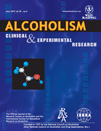Alcohol use disorders (AUDs) are a major public health problem, and the few treatment options available to those seeking treatment offer only modest success rates. There remains a need to identify novel targets for the treatment of AUDs. The neuronal nicotinic acetylcholine receptors (nAChRs) represent a potential therapeutic target in the brain, as recent human genetic studies have implicated gene variants in the α5 nAChR subunit as high risk factors for developing alcohol dependence.
Here, we evaluate the role of the α5* nAChR for ethanol (EtOH)-mediated behaviors using male α5+/+ and α5−/− transgenic mice. We characterized the effect of hypnotic doses of EtOH and investigated drinking behavior using an adapted drinking-in-the-dark (DID) paradigm that has been shown to induce high EtOH consumption in mice.
We found the α5 subunit to be important in mediating the sedative effects of EtOH. The α5−/− mice showed slower recovery from EtOH-induced sleep, as measured by loss of righting reflex. Additionally, the α5−/− mice showed enhanced impairment to EtOH-induced ataxia. We found the initial sensitivity to EtOH and EtOH metabolism to be similar in both α5+/+ and α5−/− mice. Hence, the enhanced sedation is likely due to a difference in the acute tolerance of EtOH in α5−/− mice. However, the α5 subunit did not play a role in EtOH consumption for EtOH concentrations ranging from 5 to 30% using the DID paradigm. Additionally, varenicline was effective in reducing EtOH intake in α5−/− mice.
Together, our data suggest that the α5 nAChR subunit is important for the sedative effects of EtOH but does not play a role in EtOH consumption in male mice. Varenicline can be a treatment option even when there is loss of function of the α5 nAChR subunit.
Read Full Abstract
Request Reprint E-Mail: selena.bartlett@qut.edu.au
Together, our data suggest that the α5 nAChR subunit is important for the sedative effects of EtOH but does not play a role in EtOH consumption in male mice. Varenicline can be a treatment option even when there is loss of function of the α5 nAChR subunit.
Read Full Abstract
Request Reprint E-Mail: selena.bartlett@qut.edu.au
